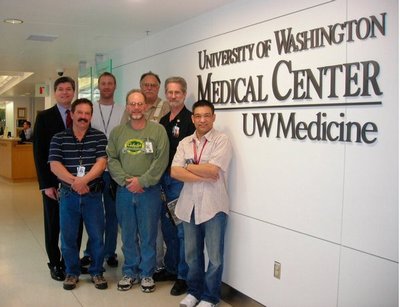May 22, 2008
On the job with UWMC Operations & Maintenance
A hospital building is much like the people inside of it.
Its structure is like a skeleton, while its plumbing is like the circulatory system. The roof is similar to a person’s scalp and hair, while the exterior is the skin. And the heart? The chillers and boilers that keep air and water warm and cool throughout the whole building.
And like a human body, a hospital requires maintenance and repair.
“You’ve got to take care of all the body parts,” said Don Larson, director of UW Medical Center’s Operations & Maintenance. “Buildings are like people.”
A team of 47 people cares for UW Medical Center — every day, all day and night. They take care of the building from the roof to the grounds and everything in between. Larson’s office fields 8,000 to 10,000 calls a year, most of which are coordinated by the front office staff.
“We support anything and everything that has to do with the building,” he said.
Larson’s crews of plumbers, electricians, machinery mechanics, carpenters and all-around facility operations and maintenance specialists care for everything except medical equipment. They take care of everything that doesn’t have a service agreement, which includes about 7,600 pieces of equipment. Operations & Maintenance crews install lights, repair the heating, stop leaky faucets, replace hand controls for the nurse call system patients use, maintain the heating, ventilation and air conditioning system, fix doorknobs and move walls.
Facility operation maintenance specialists — also called FOMs, for short — “are our front line, responding to just about everything,” Larson said.
FOMs and plumbers unstop about 12 toilets a week, as well as handling problems with dialysis drains and floods from broken pipes, said Ken Feilen, program operations manager for Operations & Maintenance. The staff also deal with the glitches of a new building. Even though the Surgery Pavilion is relatively new, the building has settled a bit — as buildings always do — which means doors don’t always shut, noted Mike Bussert, manager of program operations for Operations & Maintenance.
It’s this variety of jobs — from the simple to the complex — that keep so many skilled trades people at UWMC, Feilen said.
David Ketcherside, a machinery master mechanic, came to UWMC six years ago after a varied career as a musician and artist. He creates cartoons and illustrations, as well as concepts for video games. He enjoys working with his co-workers, who are always willing to lend a hand.
Like Ketcherside, many of the Operations & Maintenance workers have diverse backgrounds. One former refrigerator mechanic who retired last year earned a master’s degree and has deep knowledge of quantum physics. Another employee, Posin Siev, was a captain pilot of the transport plane C123k in the Cambodian Air Force for five years in the early 1970s before immigrating to the United States.
“You never know what brought people here,” Ketcherside said.
When he arrived in the U.S., Siev never imagined he could be successful. Grateful to have gotten out of war-torn Cambodia, he thought he would just “mow lawns for people.” Once in Washington, Siev trained as an electrician and then learned to drywall and install acoustic ceilings. He has worked at UWMC since 1999.
UWMC is fortunate to have a full-time maintenance crew, Larson said, as many hospitals are maintained by “two guys and a Rolodex” full of names and numbers for freelance contractors.
“The most significant change for us is working in patient care environments in which we have strict infection controls,” Larson said.
For instance, patients in cancer treatment areas have low immunity, so workers must be extremely careful that they “don’t create dust or particle levels that increase the level of illness of the patient,” Larson said. This means workers use HEPA filters to clean the air and build containment cubes that attach to the ceilings so particles do not escape.
The oldest part of UWMC was built in the late ‘50s and opened in 1959. The Muilenberg Tower was built in the mid-1980s, while the Surgery Pavilion opened in 2003. The building has 1.5 million square feet in all. Power for the medical center comes from the upper campus power plant, which also provides back-up generators in case the hospital loses power.
Many people who visit and work in UWMC are unaware of the miles of pipes, hundreds of fan units and pumps and the massive equipment that it takes to keep the hospital going, Ketcherside said.
“This crew that takes care of this equipment is probably the most experienced, thoughtful, service-oriented and nicest group of people that I have ever worked with,” Ketcherside said. “On many days, they are the only reason I have the energy to come into work.”
Operations & Maintenance staff play a large part in maintaining the hospital’s accreditation from The Joint Commission (TJC). To ensure that the hospital meets fire, life and safety regulations, crews make sure ceilings and walls are intact and that the sprinkler system works. In addition, all fire exits must be open and doors must latch properly.
Workers also maintain other building systems such as water, sewer, medical gasses and steam. Larson constantly monitors The Joint Commission’s regulations to make sure UWMC complies with them.
“A large part of our survey includes a fire and life safety survey,” said Patty Riley, assistant administrator for support services at UWMC. “This is primarily the maintenance of our fire safety system and maintaining our utilities and emergency backup systems. We had a great outcome this last TJC survey in September…due to the excellent and thorough work of our Operations & Maintenance staff.”
While Operations & Maintenance workers aren’t delivering medical services, they feel good about their work because they support the people who do.
“We’re helping people get well in the end,” Larson said.

